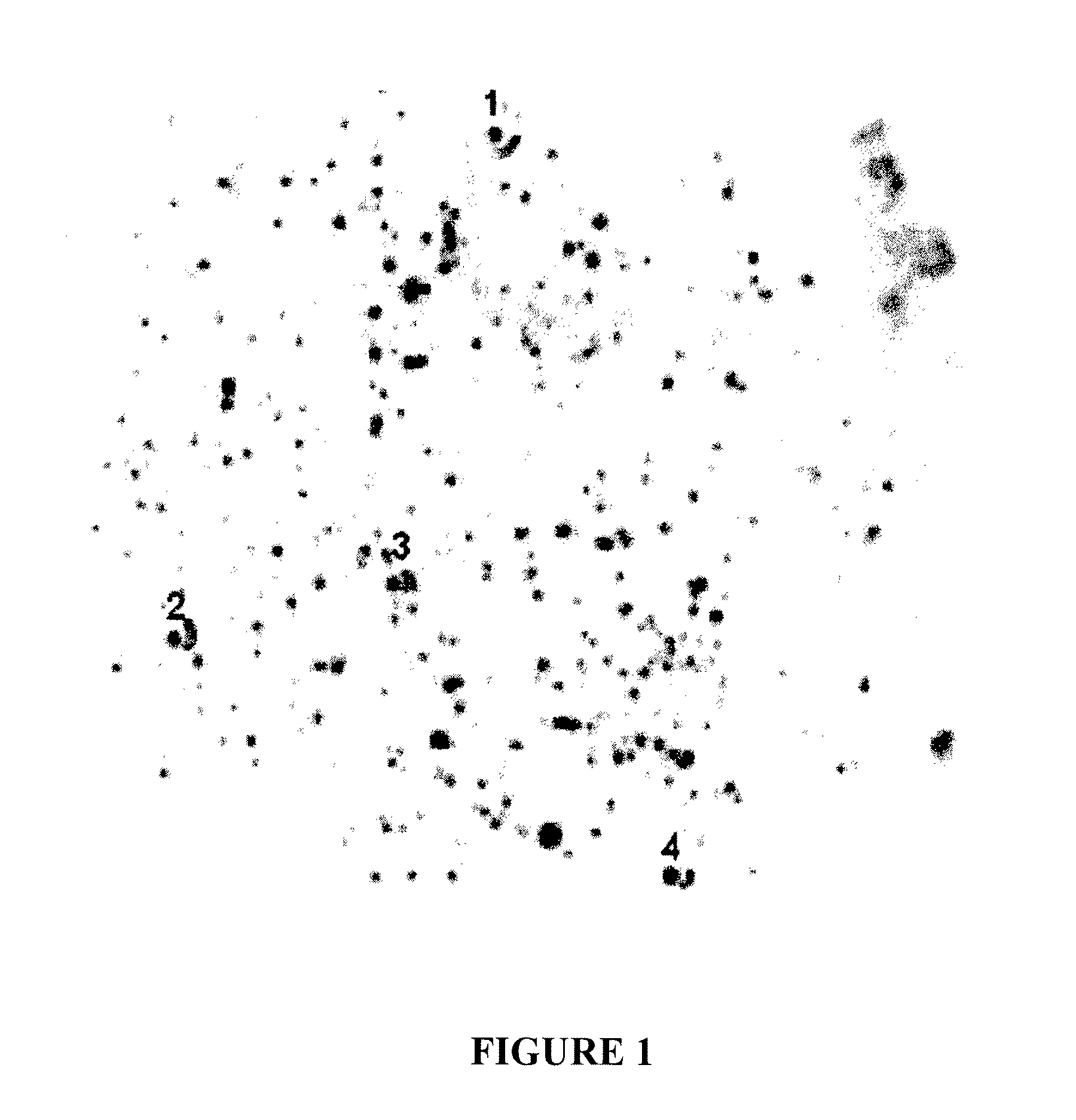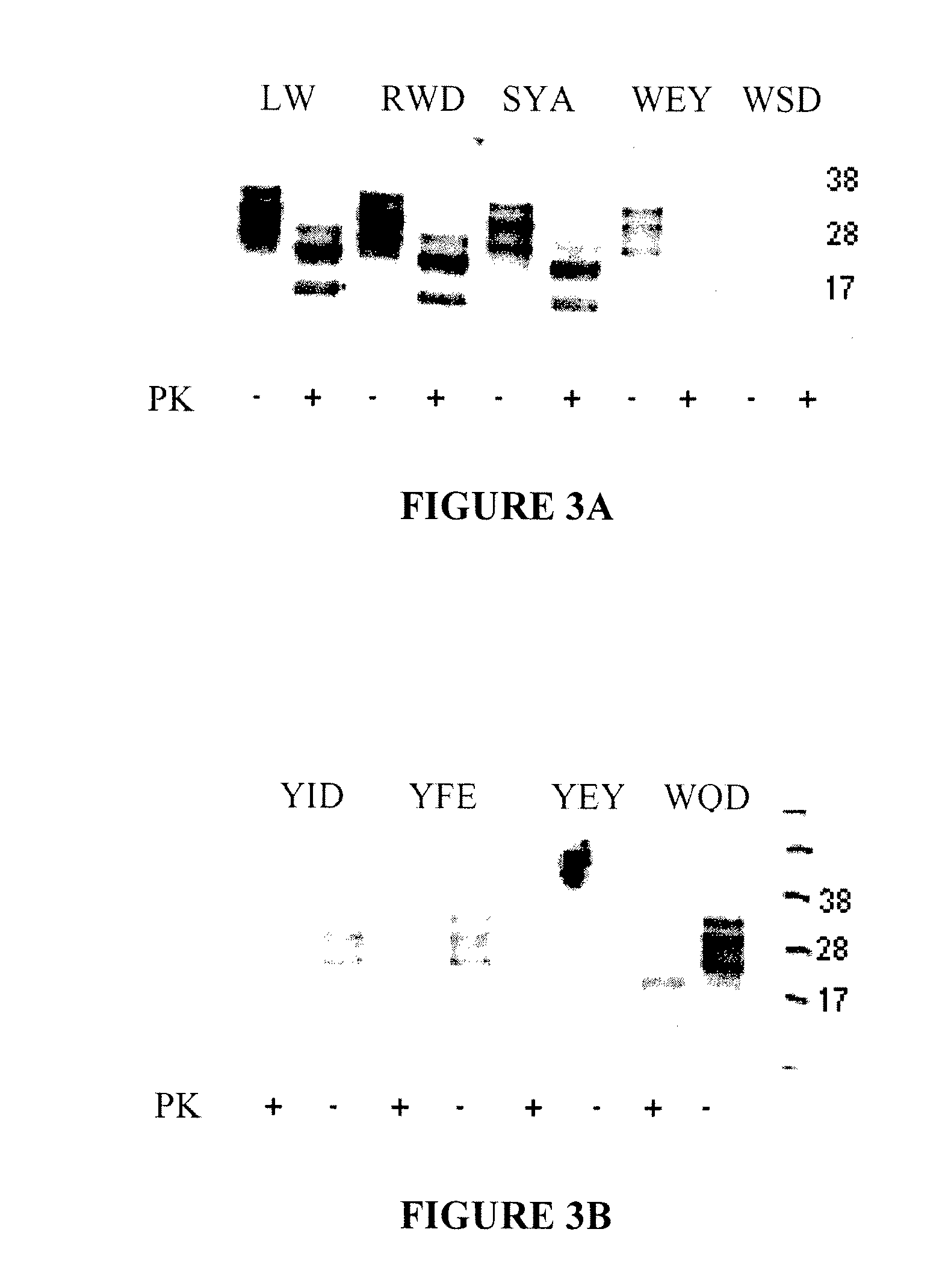Prion protein ligands and methods of use
a technology of protein ligands and prion, which is applied in the field of protein ligand interaction, can solve the problems of inability to identify infected animals using conventional serologic tests, unable to produce antibodies, and difficulty in selective inactivation, so as to slow down the development of further prps
- Summary
- Abstract
- Description
- Claims
- Application Information
AI Technical Summary
Benefits of technology
Problems solved by technology
Method used
Image
Examples
example 1
Identification of Prion-Binding Ligands
[0134]The prion-binding ligands described in the Tables set forth herein were identified as follows.
[0135]The peptides and peptide libraries useful for the identification of the prion-binding ligands described herein were synthesized by either Peptides International (Louisville, Ky.) or Commonwealth Biotechnologies (Richmond, Va.) directly on Toyopearl amino resin (TosoBioSep, Montgomeryville, Pa.) using standard Fmoc chemistry based on methods described by Buettner, et al. 1996. Peptide densities achieved with the above scheme were typically in the range of 0.1-0.5 mmole / gram resin. Libraries comprising 1, 2, 3, 4, 5 and 6 amino acids were synthesized. The 4, 5 and 6 amino acid libraries were synthesized on amino Toyopearl and contained a mixture of tBoc and Fmoc alanine as a spacer between the amino acid and the amino group on the resin. The peptides were synthesized from the Fmoc alanine and the tBoc was acetylated. ...
example 2
Secondary Screening of Ligands
[0154]The following examples provide-information on secondary screening of ligands selected from the various libraries during the primary screening to further confirm that the ligands bind PrP.
[0155]Binding of PrPc from normal human brain to trimer resins is shown in FIGS. 2A-B. Ten mg of each resin (Amino, HYD (SEQ ID NO:206)), RWD (SEQ ID NO:113), SYA (SEQ ID NO:108), SYF (SEQ ID NO:213), and YEY (SEQ ID NO:154)), per column was used. The amino resin is the base polymer from which the peptides are synthesized and has some affinity to prion protein. Resins were equilibrated with either PBS, or CPD at pH 7.4. Frozen normal human brain tissue was used as the source of huPrPc. It was first thawed on wet ice. A sample of 10% brain homogenate prepared in PBS or in CPD was solubilized with 1% Sarcosyl and clarified by centrifugation at 14,000 rpm for five minutes. The supenatant was recovered and diluted 100 times to a final concentration of brain homogenate...
example 3
Visualization of PrPc Bound to Resins
[0160]To visualize the binding of PrPc to affinity resins, normal brain homogenate was bound to amino DVR (SEQ ID NO:114) resin in a column format, and the location of the protein in the interior and at the exterior of the beads was visualized by a chromogenic substrate. A 0.5 ml column of affinity ligand DVR (SEQ ID NO:114), which was synthesized on Toyopearl 650-M amino resin, was packed into a PIKSI column (ProMetic BioSciences Ltd, Montreal, Québec, Canada). To the column was applied 1.5 ml of 1% normal hamster brain homogenate (HaBH) diluted in a working buffer (WB) (20 mM citrate, 140 mM NaCl, pH 7.0) at a flow rate of 0.5 ml / min, which was controlled by a peristaltic pump. Following loading of HaBH, the columns were washed with 5 ml of WB. The beads were removed from the column, chopped with a razor blade to expose the interior of the beads, and incubated with primary antibody 3F4 diluted 1:4000 in 1% casein buffer (Pierce, Rockford, Ill.)...
PUM
| Property | Measurement | Unit |
|---|---|---|
| molecular weight | aaaaa | aaaaa |
| pH | aaaaa | aaaaa |
| pH | aaaaa | aaaaa |
Abstract
Description
Claims
Application Information
 Login to View More
Login to View More - R&D
- Intellectual Property
- Life Sciences
- Materials
- Tech Scout
- Unparalleled Data Quality
- Higher Quality Content
- 60% Fewer Hallucinations
Browse by: Latest US Patents, China's latest patents, Technical Efficacy Thesaurus, Application Domain, Technology Topic, Popular Technical Reports.
© 2025 PatSnap. All rights reserved.Legal|Privacy policy|Modern Slavery Act Transparency Statement|Sitemap|About US| Contact US: help@patsnap.com



